Soft Robotics: Engineering Flexible Automation for Complex Environments †
Abstract
1. Introduction
- Through 3D printing, precise and intricate designs can be created using soft materials.
- Molding and casting are used to create soft robots with complex internal channels and structural features.
- Laser cutting is used for the precise customization of material sheets before assembly.
2. Literature Review
3. Application of Soft Robots
- Rehabilitation devices: Wearable soft robotics, such as gloves and braces, are used in rehabilitation for stroke survivors to assist with movement recovery.
- Underwater exploration: Hydraulic soft robots are designed for exploring fragile underwater ecosystems without causing harm.
4. Case Study on Soft Robotics in Agricultural Produce Handling
Design and Fabrication of a Soft Robotic Gripper
5. Experimental Setup and Methodology
- Controlled environment: Greenhouse
- Robots: Soft robotic gripper and a traditional rigid robotic gripper.
- Sample size: 100 strawberries and 100 tomatoes for each gripper type.
6. Results and Comparisons
7. Challenges and Limitations
8. Conclusions
Funding
Institutional Review Board Statement
Informed Consent Statement
Data Availability Statement
Acknowledgments
Conflicts of Interest
References
- Kim, S.; Laschi, C.; Trimmer, B. Soft robotics: A bioinspired evolution in robotics. Trends Biotechnol. 2013, 31, 287–294. [Google Scholar] [CrossRef] [PubMed]
- Rus, D.; Tolley, M.T. Design, fabrication and control of soft robots. Nature 2015, 521, 467–475. [Google Scholar] [CrossRef] [PubMed]
- Zhao, X.; Huang, Q. Material innovations in soft robotics. Adv. Mater. 2016, 28, 4194–4202. [Google Scholar]
- Shepherd, R.F.; Ilievski, F. Multigait soft robot. Proc. Natl. Acad. Sci. USA 2011, 108, 20400–20403. [Google Scholar] [CrossRef]
- Wang, T.; Zhang, Y.; Fu, J. Machine learning in soft robotics control. IEEE Robot. Autom. Lett. 2022, 7, 5541–5550. [Google Scholar]
- Laschi, C.; Trimmer, B. Soft robots for healthcare and agriculture. Annu. Rev. Control. Robot. Auton. Syst. 2013, 1, 85–103. [Google Scholar]
- Leong, W.Y.; Liu, W. Structural health monitoring: Subsurface defects detection. In Proceedings of the 2009 35th Annual Conference of IEEE Industrial Electronics, Porto, Portugal, 3–5 November 2009; IEEE: Piscataway, NJ, USA, 2009; pp. 4326–4330. [Google Scholar]
- Leong, W.Y.; Genasan, N.; Zhang, J.B. Future of Medical Equipment Technology. ASM Sci. J. 2024, 19. [Google Scholar] [CrossRef]
- Yap, S.C.; Leong, W.Y.; Zhang, J.B. Development of Dialysis and Leakage Detection on Different Technology. ASM Sci. J. 2023, 18, 1–11. [Google Scholar] [CrossRef]
- Choo, K.W.; Rozana, Z.; Azlan, A.; Leong, W.Y. Various Techniques on Retrofitting for Earthquake Hazard Mitigation. Int. J. Eng. Technol. 2018, 7, 167. [Google Scholar] [CrossRef]
- Leong, W.Y. Industry 5.0: Design, Standards, Techniques and Applications for Manufacturing; Institution of Engineering and Technology, IET: Stevenage, UK, 2024. [Google Scholar]
- Ramkumar, G.; Shah, S. An Insight Study of Hard Robotics to Soft Robotics Shift within the Medical Sector. WSEAS Trans. Computers 2025, 24, 42–62. [Google Scholar] [CrossRef]
- Leong, W.Y.; Leong, Y.Z.; Leong, W.S. Poultry Precision: Exploring the Impact of IoT Sensors on Smart Farming Practices. In Proceedings of the IEEE International Workshop on Electromagnetics(iWEM 2024), Taoyuan City, Taiwan, 10–12 July 2024. [Google Scholar]
- Leong, W.Y. Digital Twin Models for Real-Time Failure Prediction in Industrial Machinery. ASM Sci. J. 2025, 20, 1–8. [Google Scholar]
- Bhagat, S.; Banerjee, H.; Ho Tse, Z.T.; Ren, H. Deep Reinforcement Learning for Soft, Flexible Robots: Brief Review with Impending Challenges. Robotics 2019, 8, 4. [Google Scholar] [CrossRef]
- Leong, W.Y. Internet of Things for Enhancing Public Safety, Disaster Response, and Emergency Management. Eng. Proc. 2025, 92, 61. [Google Scholar] [CrossRef]
- Wang, Y.; Wang, Y.; Mushtaq, R.T.; Wei, Q. Advancements in Soft Robotics: A Comprehensive Review on Actuation Methods, Materials, and Applications. Polymers 2024, 16, 1087. [Google Scholar] [CrossRef]
- Leong, W.Y.; Leong, Y.Z.; Leong, W.S. Human-Machine Interaction in the Electric Vehicle Battery Industry. In Proceedings of the 2024 10th International Conference on Applied System Innovation (ICASI), Kyoto, Japan, 17–21 April 2024; IEEE: Piscataway, NJ, USA, 2024; pp. 69–71. [Google Scholar]
- Li, G.; Wong, T.W.; Shih, B.; Guo, C.; Wang, L.; Liu, J.; Wang, T.; Liu, X.; Yan, J.; Wu, B.; et al. Bioinspired soft robots for deep-sea exploration. Nat. Commun. 2023, 14, 7097. [Google Scholar] [CrossRef]
- Hauser, H. Soft Robotics: An Introduction to the Special Issue. IEEE Control. Syst. Mag. 2023, 43, 28–29. [Google Scholar] [CrossRef]
- Chen, A.; Yin, R.; Cao, L.; Yuan, C.; Ding, H.K.; Zhang, W.J. Soft robotics: Definition and research issues. In Proceedings of the 24th International Conference on Mechatronics and Machine Vision in Practice (M2VIP), Auckland, New Zealand, 21–23 November 2017; pp. 366–370. [Google Scholar]
- Chen, F.; Wang, M.Y. Design Optimization of Soft Robots: A Review of the State of the Art. IEEE Robot. Autom. Mag. 2020, 27, 27–43. [Google Scholar] [CrossRef]
- Ambaye, G.; Boldsaikhan, E.; Krishnan, K. Soft Robot Design, Manufacturing, and Operation Challenges: A Review. J. Manuf. Mater. Process 2024, 8, 79. [Google Scholar] [CrossRef]
- Sut, D.J.; Sethuramalingam, P. Soft Manipulator for Soft Robotic Applications: A Review. J. Intell. Robot. Syst. 2023, 108, 10. [Google Scholar] [CrossRef]
- Trivedi, D.; Rahn, C.D.; Kier, W.M.; Walker, I.D. Soft robotics: Biological inspiration, state of the art, and future research. Appl. Bionics Biomech. 2008, 5, 99–117. [Google Scholar] [CrossRef]
- Qin, L.; Peng, H.; Huang, X.; Liu, M.; Huang, W. Modeling and Simulation of Dynamics in Soft Robotics: A Review of Numerical Approaches. Curr. Robot. Rep. 2024, 5, 1–13. [Google Scholar] [CrossRef]
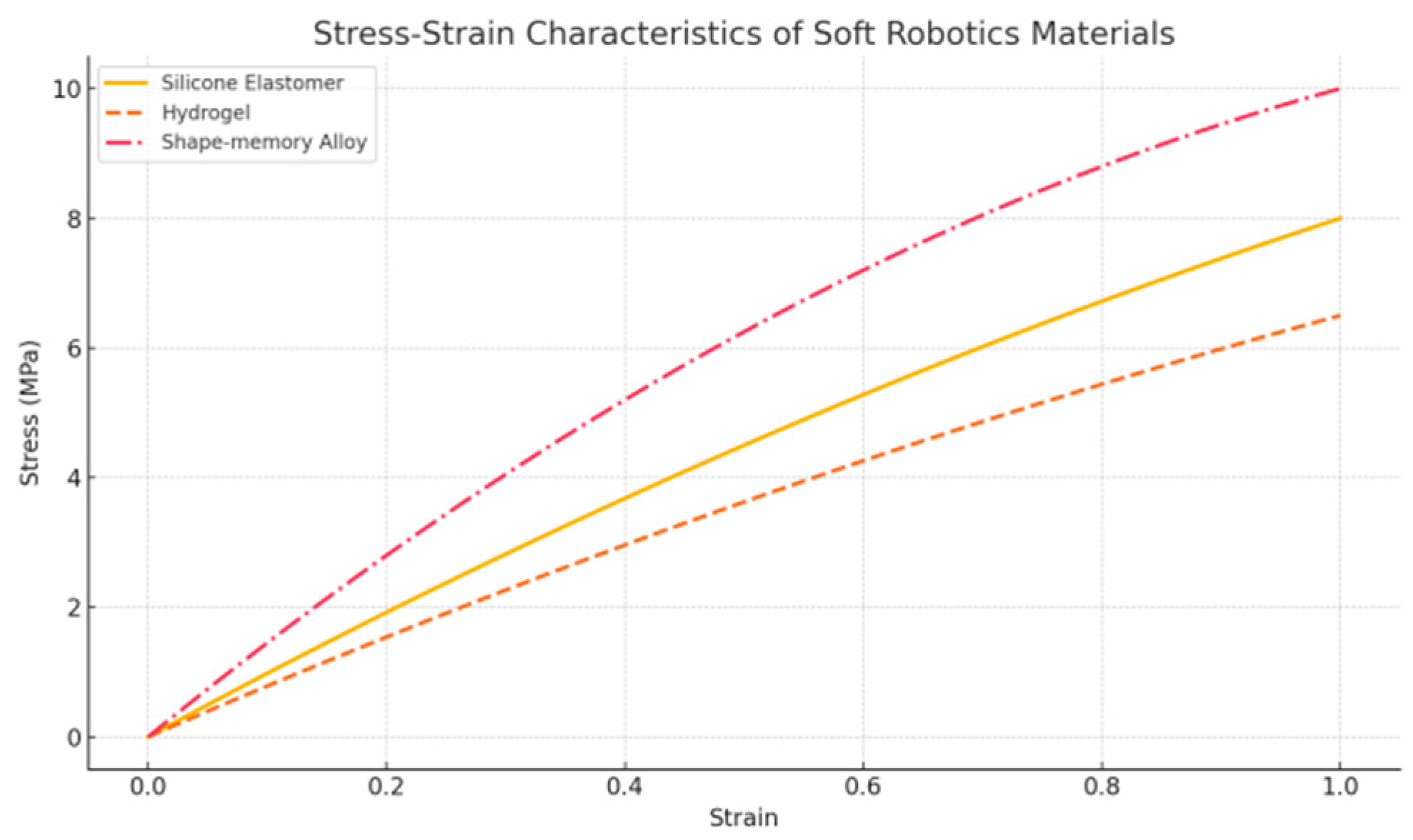


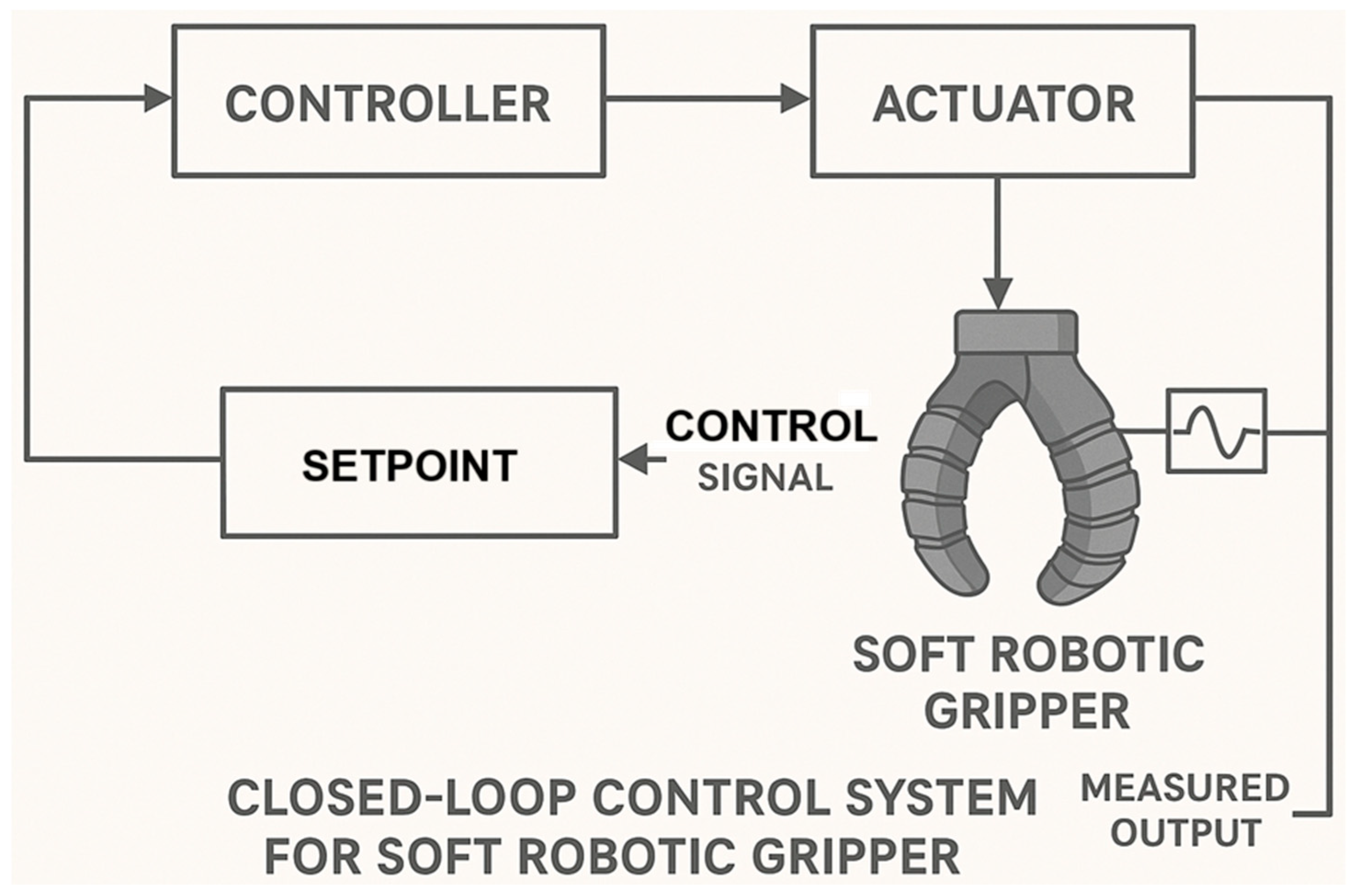
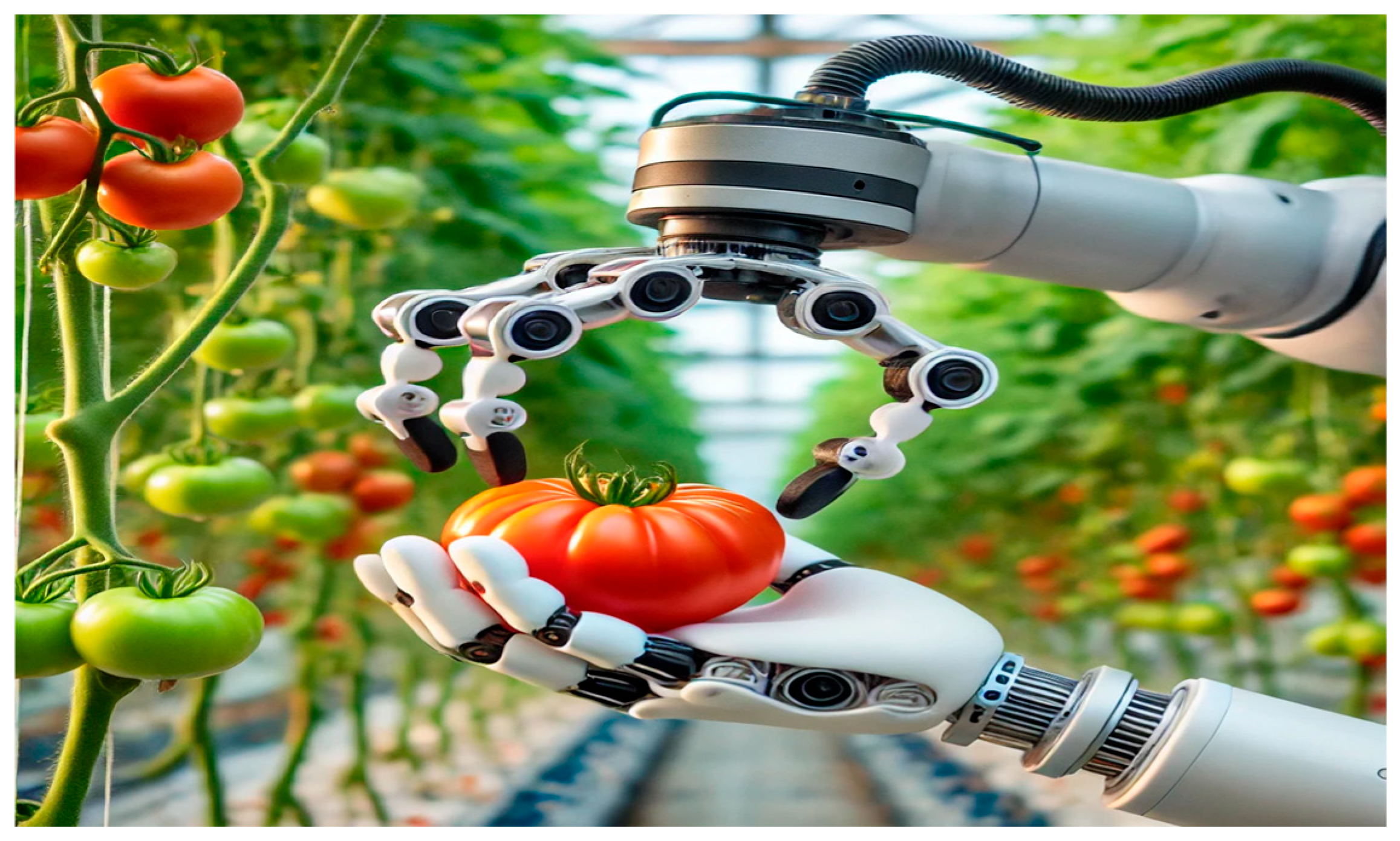
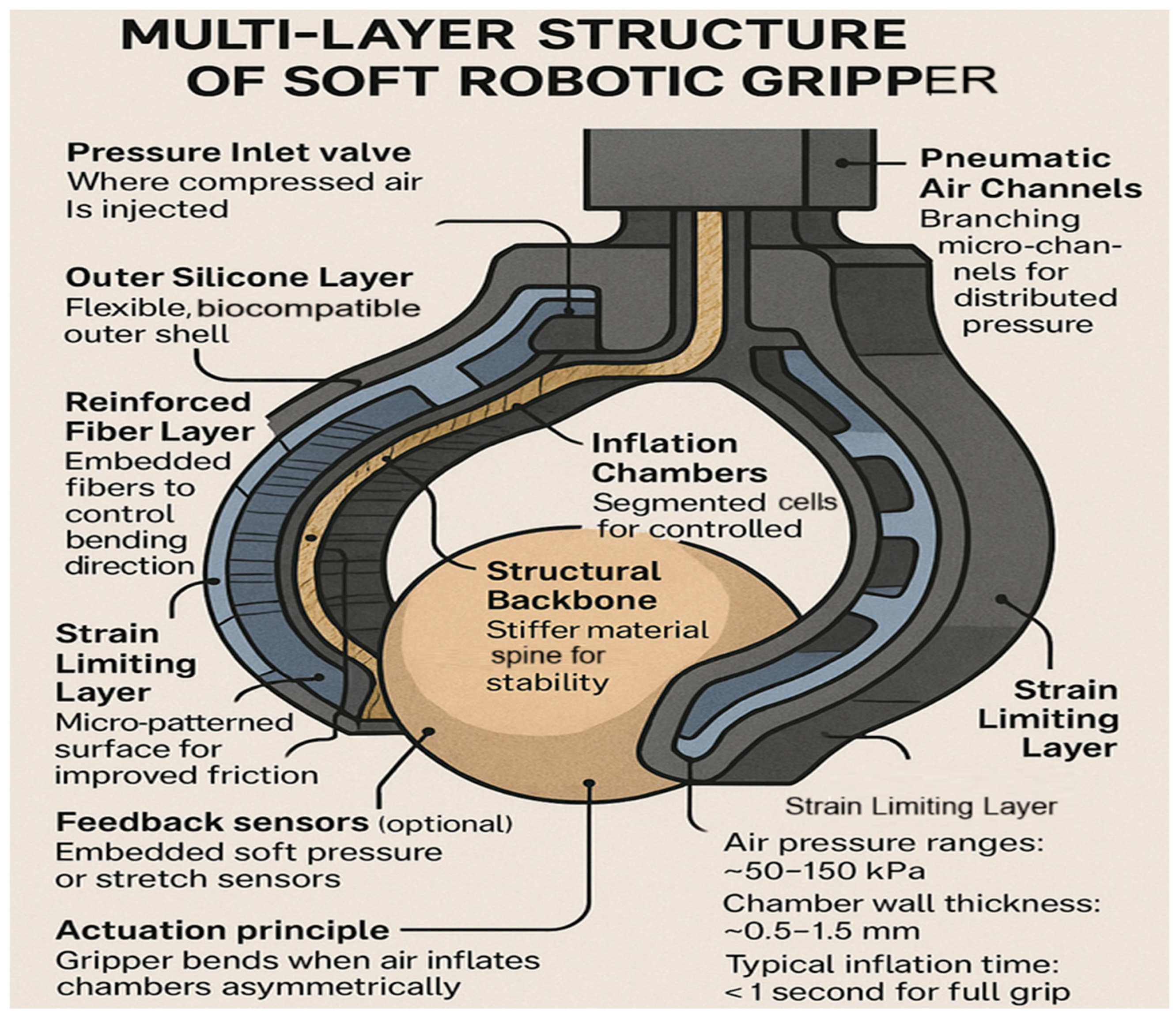

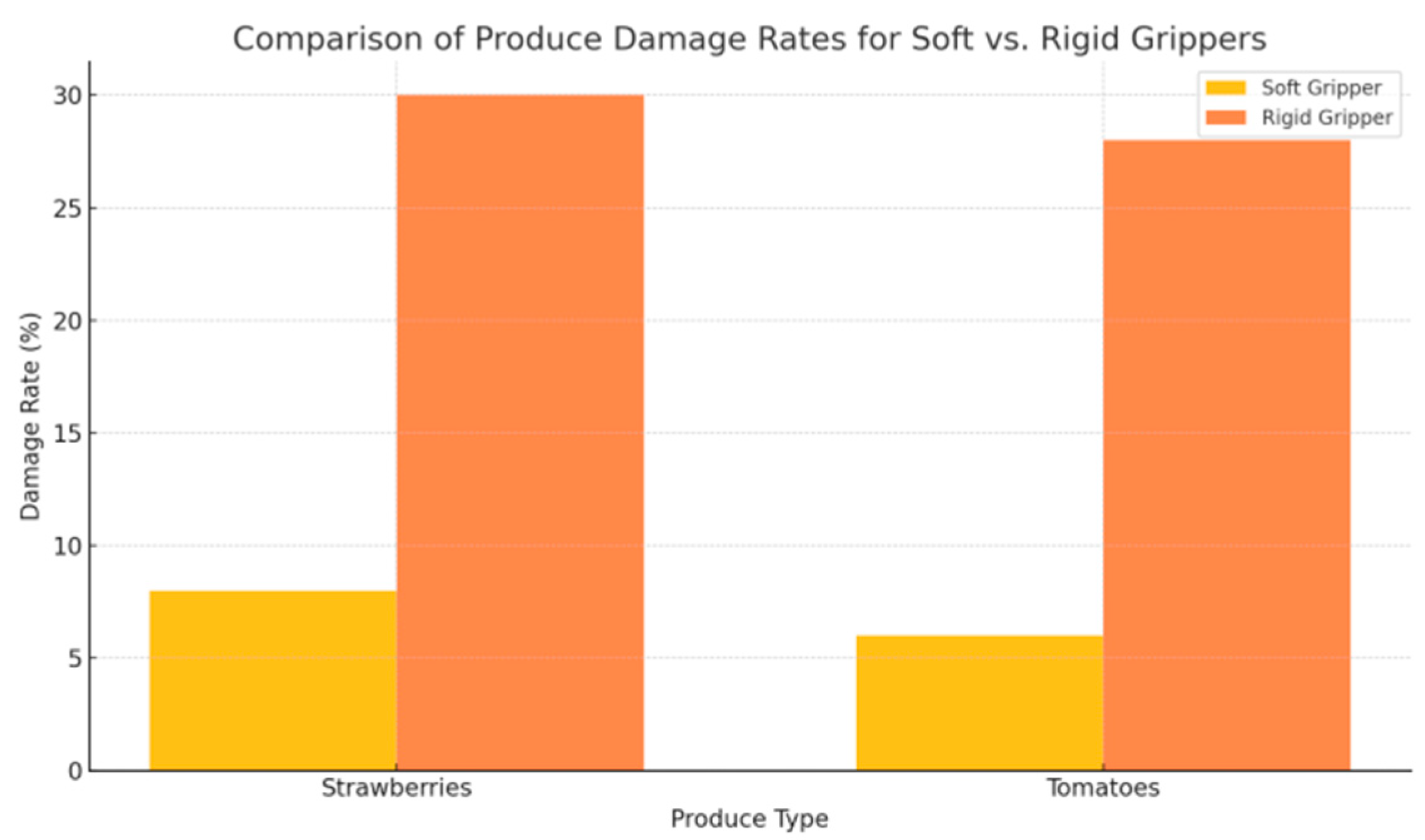

| Material | Properties | Applications |
|---|---|---|
| Silicone elastomers | High flexibility, biocompatible | Medical devices, soft actuators |
| Hydrogels | Soft and responsive to stimuli | Environmental monitoring, prosthetics |
| Shape-memory alloys | Deform and return to shape | Wearable robots, exoskeletons |
| Actuator Type | Description | Advantages |
|---|---|---|
| Pneumatic actuators | Utilize air pressure for movement | Lightweight, versatile |
| Hydraulic actuators | Use liquid for high-force applications | Effective in water environments |
| Electroactive polymers | Respond to electrical stimuli | Fast and responsive control |
| Feature | Soft Robots | Rigid Robots |
|---|---|---|
| Flexibility | High | Low |
| Impact Resistance | High | Moderate |
| Navigation Efficiency | Dependent on environment | Effective in structured paths |
| Cost | Moderate | Varies |
| Parameter | Soft Robotic Gripper | Rigid Robotic Gripper |
|---|---|---|
| Produce Type | Strawberries, tomatoes | Strawberries, tomatoes |
| Average Grip Pressure | 0.3 MPa | 1.5 MPa |
| Control Type | Closed-loop feedback | Pre-programmed force |
| Material Used | Silicone elastomer | Stainless steel |
| Metric | Soft Robotic Gripper | Rigid Robotic Gripper |
|---|---|---|
| Average Handling Time | 4 s/item | 3 s/item |
| Damage Rate: Strawberries | 8% | 30% |
| Damage Rate: Tomatoes | 6% | 28% |
| Energy Consumption | Low | High |
Disclaimer/Publisher’s Note: The statements, opinions and data contained in all publications are solely those of the individual author(s) and contributor(s) and not of MDPI and/or the editor(s). MDPI and/or the editor(s) disclaim responsibility for any injury to people or property resulting from any ideas, methods, instructions or products referred to in the content. |
© 2025 by the author. Licensee MDPI, Basel, Switzerland. This article is an open access article distributed under the terms and conditions of the Creative Commons Attribution (CC BY) license (https://creativecommons.org/licenses/by/4.0/).
Share and Cite
Leong, W.Y. Soft Robotics: Engineering Flexible Automation for Complex Environments. Eng. Proc. 2025, 92, 65. https://doi.org/10.3390/engproc2025092065
Leong WY. Soft Robotics: Engineering Flexible Automation for Complex Environments. Engineering Proceedings. 2025; 92(1):65. https://doi.org/10.3390/engproc2025092065
Chicago/Turabian StyleLeong, Wai Yie. 2025. "Soft Robotics: Engineering Flexible Automation for Complex Environments" Engineering Proceedings 92, no. 1: 65. https://doi.org/10.3390/engproc2025092065
APA StyleLeong, W. Y. (2025). Soft Robotics: Engineering Flexible Automation for Complex Environments. Engineering Proceedings, 92(1), 65. https://doi.org/10.3390/engproc2025092065








